AMD’s 5 GHz Turbo CPU in Retail: The FX-9590 and ASRock 990FX Extreme9 Review
by Ian Cutress on August 9, 2014 8:00 AM ESTMany thanks to...
We must thank the following companies for kindly providing hardware for our test bed:
Thank you to OCZ for providing us with PSUs and SSDs.
Thank you to G.Skill and ADATA for providing us with memory kits.
Thank you to Corsair for providing us with an AX1200i PSU, Corsair H80i CLC and DRAM.
Thank you to ASUS for providing us with the AMD HD7970 GPUs and some IO Testing kit.
Thank you to MSI for providing us with the NVIDIA GTX 770 Lightning GPUs.
Thank you to Rosewill for providing us with PSUs and RK-9100 keyboards.
Thank you to ASRock for providing us with some IO testing kit.
Test Setup
| Test Setup | |
| Processor |
AMD FX-9590 4 Modules, 8 Threads, 4.7 GHz, 5.0 GHz Turbo |
| Motherboards | ASRock 990FX Extreme9 |
| Cooling |
Corsair H80i Thermalright TRUE Copper |
| Power Supply |
OCZ 1250W Gold ZX Series Corsair AX1200i Platinum PSU |
| Memory | G.Skill RipjawsZ 4x4 GB DDR3-1866 9-11-9 Kit |
| Memory Settings | DDR3-1866 8-9-9 |
| Video Cards | MSI GTX 770 Lightning 2GB (1150/1202 Boost) |
| Video Drivers | NVIDIA Drivers 337 |
| Hard Drive | OCZ Vertex 3 256GB |
| Optical Drive | LG GH22NS50 |
| Case | Open Test Bed |
| Operating System | Windows 7 64-bit SP1 |
| USB 2/3 Testing | OCZ Vertex 3 240GB with SATA->USB Adaptor |
| WiFi Testing | D-Link DIR-865L 802.11ac Dual Band Router |
System Benchmarks
Power Consumption
Power consumption was tested on the system as a whole with a wall meter connected to the OCZ 1250W power supply, while in a single MSI GTX 770 Lightning GPU configuration. This power supply is Gold rated, and as I am in the UK on a 230-240 V supply, leads to ~75% efficiency > 50W, and 90%+ efficiency at 250W, which is suitable for both idle and multi-GPU loading. This method of power reading allows us to compare the power management of the UEFI and the board to supply components with power under load, and includes typical PSU losses due to efficiency. These are the real world values that consumers may expect from a typical system (minus the monitor) using this motherboard.
While this method for power measurement may not be ideal, and you feel these numbers are not representative due to the high wattage power supply being used (we use the same PSU to remain consistent over a series of reviews, and the fact that some boards on our test bed get tested with three or four high powered GPUs), the important point to take away is the relationship between the numbers. These boards are all under the same conditions, and thus the differences between them should be easy to spot.
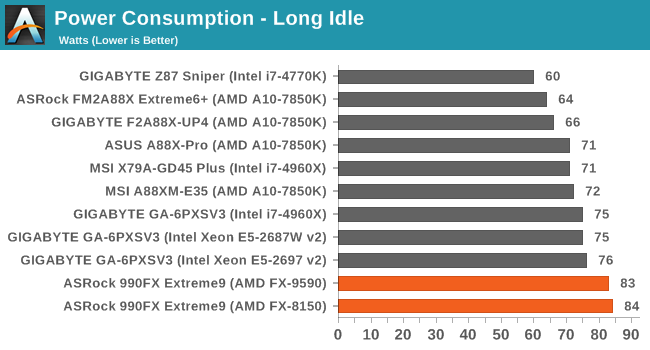
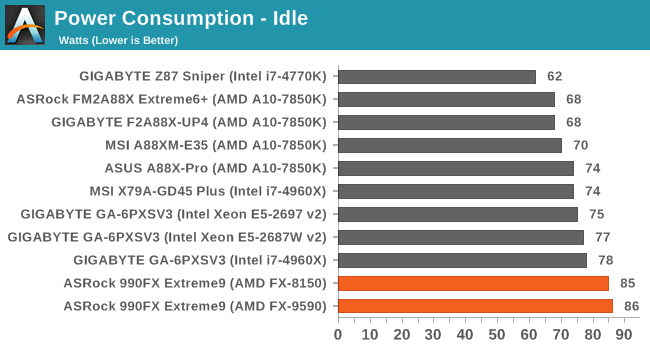
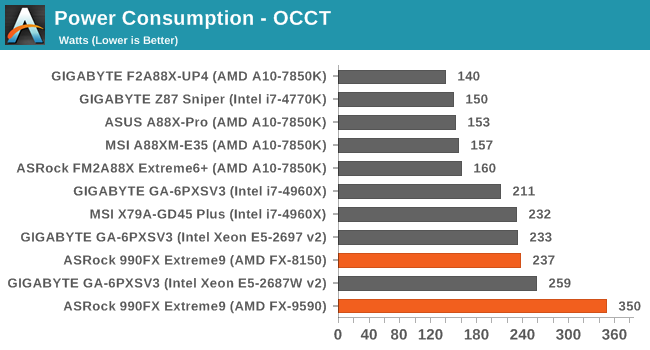
The added power draw of the FX-9590 is quite clear, showing 350W for the full system during a heavy CPU load. However, the idle power draw of the CPU is similar to that of the FX-8150.
Windows 7 POST Time
Different motherboards have different POST sequences before an operating system is initialized. A lot of this is dependent on the board itself, and POST boot time is determined by the controllers on board (and the sequence of how those extras are organized). As part of our testing, we are now going to look at the POST Boot Time - this is the time from pressing the ON button on the computer to when Windows 7 starts loading. (We discount Windows loading as it is highly variable given Windows specific features.) These results are subject to human error, so please allow +/- 1 second in these results.
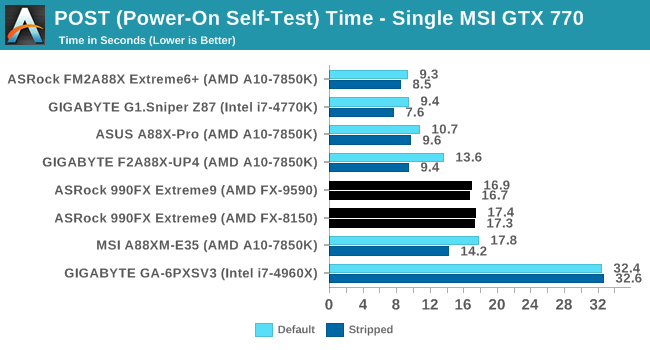
The FX-9590 afforded a shorter POST time than the FX-8150, although both are north of 16 seconds.
Rightmark Audio Analyzer 6.2.5
The premise behind Rightmark:AA is to test the input and output of the audio system to determine noise levels, range, harmonic distortion, stereo crosstalk and so forth. Rightmark:AA should indicate how well the sound system is built and isolated from electrical interference (either internally or externally). For this test we connect the Line Out to the Line In using a short six inch 3.5mm to 3.5mm high-quality jack, turn the OS speaker volume to 100%, and run the Rightmark default test suite at 192 kHz, 24-bit. The OS is tuned to 192 kHz/24-bit input and output, and the Line-In volume is adjusted until we have the best RMAA value in the mini-pretest. We look specifically at the Dynamic Range of the audio codec used on board, as well as the Total Harmonic Distortion + Noise.
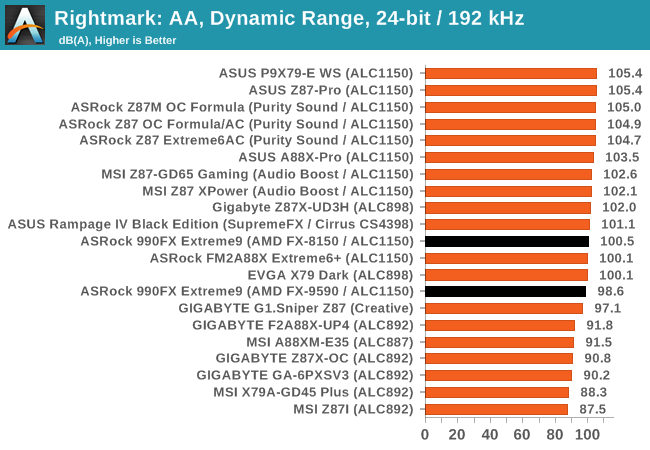
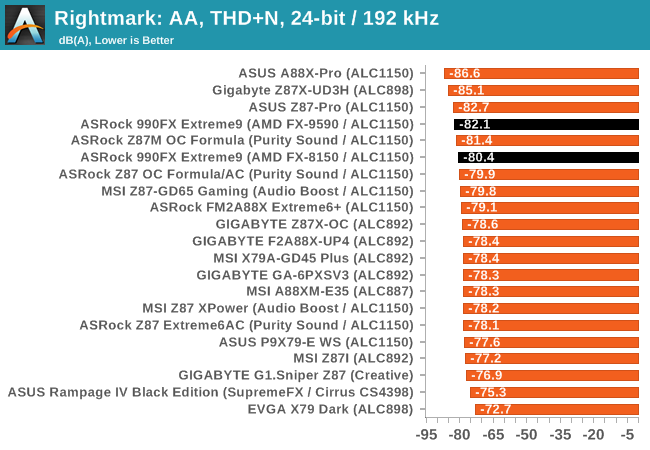
USB Backup
For this benchmark, we run CrystalDiskMark to determine the ideal sequential read and write speeds for the USB port using our 240 GB OCZ Vertex3 SSD with a SATA 6 Gbps to USB 3.0 converter. Then we transfer a set size of files from the SSD to the USB drive using DiskBench, which monitors the time taken to transfer. The files transferred are a 1.52 GB set of 2867 files across 320 folders – 95% of these files are small typical website files, and the rest (90% of the size) are the videos used in the WinRAR test. In an update to pre-Z87 testing, we also run MaxCPU to load up one of the threads during the test which improves general performance up to 15% by causing all the internal pathways to run at full speed.
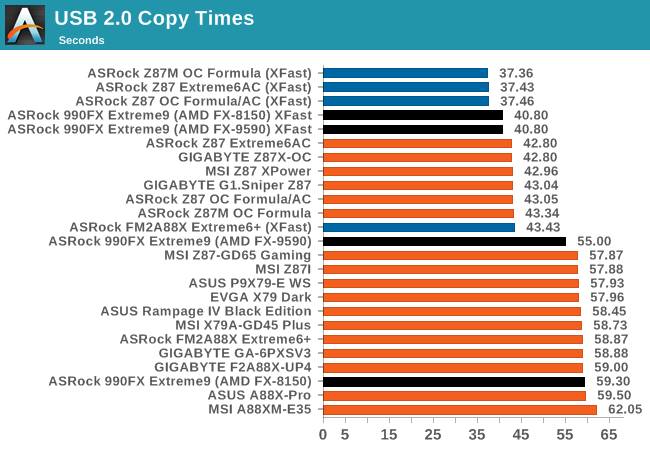
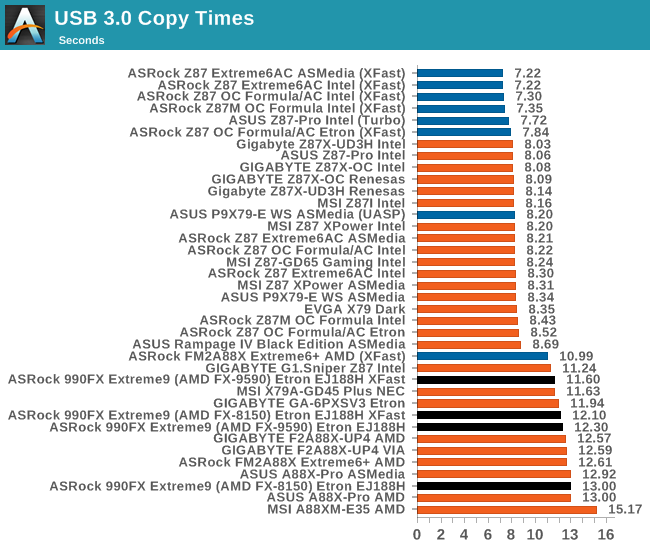
The increase in CPU speed of the FX-9590 gives a measured improvement in standard USB copy times – saving 4.3 seconds over the FX-8150 for USB 2.0 transfers. However using XFast USB eliminated that difference completely. For USB 3.0 transfers, using the Etron controller put a consistent advantage on the side of the FX-9590.
DPC Latency
Deferred Procedure Call latency is a way in which Windows handles interrupt servicing. In order to wait for a processor to acknowledge the request, the system will queue all interrupt requests by priority. Critical interrupts will be handled as soon as possible, whereas lesser priority requests, such as audio, will be further down the line. So if the audio device requires data, it will have to wait until the request is processed before the buffer is filled. If the device drivers of higher priority components in a system are poorly implemented, this can cause delays in request scheduling and process time, resulting in an empty audio buffer – this leads to characteristic audible pauses, pops and clicks. Having a bigger buffer and correctly implemented system drivers obviously helps in this regard. The DPC latency checker measures how much time is processing DPCs from driver invocation – the lower the value will result in better audio transfer at smaller buffer sizes. Results are measured in microseconds and taken as the peak latency while cycling through a series of short HD videos - less than 500 microseconds usually gets the green light, but the lower the better.
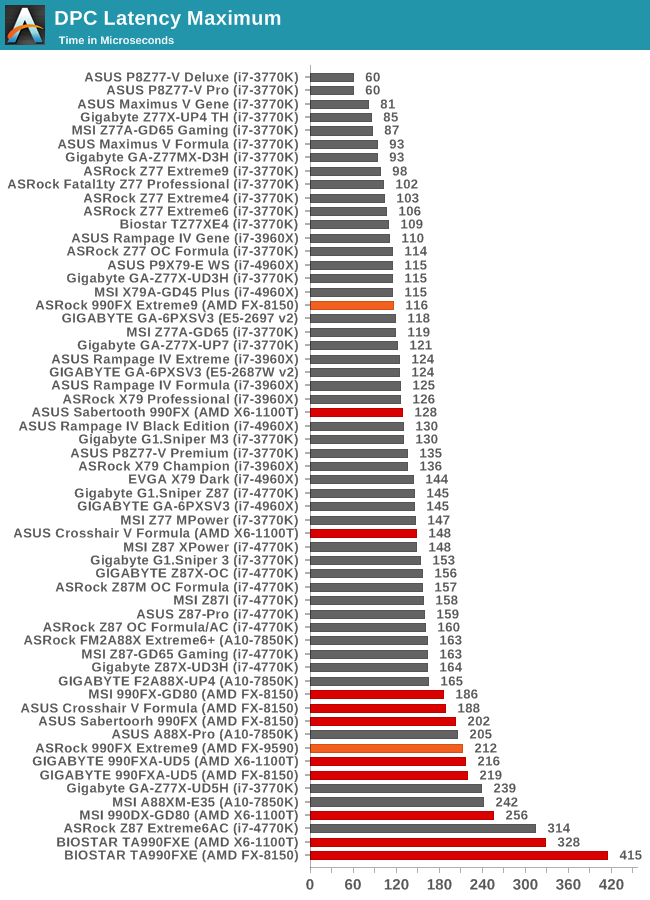
In a surprising twist, it would seem the FX-9590 has a disadvantage for DPC latency. I would have expected the faster processor to have the lower result, but one might speculate that the BIOS is tuned more for the mainstream processors such as the FX-8150. The chipset might also be geared more to the FX-8150 as it was the earlier generation compared to the FX-9590.










146 Comments
View All Comments
Budburnicus - Wednesday, January 14, 2015 - link
Umm you KNOW that even stock clocked that the i7-3770K is better and faster in EVERY way, than the 9590 OCed to the max, right?You also know that while you saved, literally, a couple bucks on BUYING your hardware - you are going to spend, comparatively, hundreds of dollars more running it for even 2 years!
Oh then there is the effect that the HUGE power draw has on components - mobos, PSUs, video cards, RAM - because ALL of it gets effected by the insane heat - and certainly ALL of it will be effected if you short your PSU!
And i7-3770K at stock frequencies out performing this POS FX 9590 - is NOT synthetic! That is real world PROVEN speed! NTM, you can EASILY hit 4.7 GHz on any SandyBridge chip - which will not only yield MUCH better performance, but will suck less power and be more reliable as well! And you aren't even going to have to spend that much to buy a good Z77 board and an i5/i7 2500k/2600k (ASRock Z77 Extreme 4 runs right around $100 right now, and is FAR from any budget board, and in fact has more features than ANY FX board that could run this 220W POS!)
So pat yourself on the back, you saved a few bucks on hardware! BUT you completely sacrificed ALL performance, and ANY reasonable upgradability! Also, you will end up paying FAR more than you saved in power costs! (I am sure your power company will thank you for choosing an AMD space heater for a CPU!)
Well on that note, you may save a few bucks on heating, given you live somewhere that gets colder than 50 degrees (Fahrenheit) at some point in the year anyway.
Budburnicus - Wednesday, January 14, 2015 - link
LMAO! Cult - you are such an AMD fanboy NOOB! It is not a cult when PERFORMANCE and EFFICIENCY are the deciding factors!And again, you saved a few bucks when buying your already outdated POS AMD space heater - just wait til that power bill comes!
And if you seriously cannot afford an i5/i7 K processor, even a Sandy or Ivy Bridge, and a Z77 or newer chipset, what the hell good is faster ram and an SSD going to do you? None, unless your workload is entirely composed of highly multi threaded compression/encoding etc.
Have fun with your 220W space heater that has to compete against i3 CPUS! LMFAO!
Budburnicus - Saturday, January 10, 2015 - link
Just another instance of AMD CHUGGING power and crapping performance! Combine this FLOP of a chip (220 W TDP - sweet Jesus! At STOCK) with an R9 290X (300 W TDP, again holy sh*t!) and you are up to over 500 watts TDP!Compare this to an Intel i7-5930K (140 W TDP) paired with a GTX 970 (148 W TDP) and you are ONLY at 288!
Not ONLY that, but the Intel is faster BY FAR at stock speeds, as well the GTX 970, while costing only $30 more - provides ~10%-25% frame rates in basically EVERY benchmark!
I just feel sad for AMD anymore... I am guessing they are too busy with owning ATI and TRYING to compete with SandyBridge and newer Intel products (My i7-2600K beats this FX chip at STOCK speeds in most benchmarks - and basically ALL gaming benchmarks! And that is not even mentioning that the 2600K easily hits 4.4 GHz on any decent mobo/chipset! Then there is the fact that the 2600K is THREE years old, only 95 W TDP - which will NEVER go above 125 even at the 4.7 GHz/102.3 Bclock OC I run!)
AMD should have realized this Chip's Architecture was DOA with the first PileDriver CPUs falling FAR behind the Phenom 2 1100Ts! And even now the 1100Ts generally have better gaming performance!
The REAL question is, WHY? Why have they not dropped this design and brought us a new one? I mean they could try it with limited releases to test it at VERY least, but I hear no word whatsoever about AMD being anywhere close to a completely new chip design!
I was a staunch "AMD Fan-boy" back in the Pentium 4/Athlon XP days! They WERE far better! Also back then ATI could actually compete in gaming!
Now? AMD is only good for budget gaming builds - parts like this FX chip are just about pointless - apart from people who already own a good socket AM3+ mobo. But buying this chip for a breand new build? That would be a HORRIBLE idea! Only the biggest fans of AMD would waste such money and power..
And AMD VideoCards - yes they have better compute performance - so yeah, if you are still GPU mining new Crypto's (Like VertCoin's Lyra2RE Algorithm) - buy an AMD GPU, but 2 or 3 if that is your goal! But even then, apparently the HD 7000 series are STILL the best miners, as they do not consume INSANE amounts of power and do NOT run at a "SAFE 95 deg C" (AMD's quote on R9 290X operating temp!) So, whereas Nvidia and Intel move forward with less power consumption, cooler temps, and better performance where it matters, it REALLY seems AMD is taking steps backwards!
SviatA - Friday, October 30, 2015 - link
So this motherboard suits basically for those who will overclock the processor, graphics and RAM.Honestly, I don't know why would any purchase a AM3+-based motherboard since we have to wait for eight months only to get some AMD Zen processors that are (at least on paper) much better than FX. So, I am thinking about the new motherboard and a new processor. Since Doom 4 will come out next year, will have to get something better than my current configuration, that is based on the ASRock 970 R2.0 (BTW, this is a pretty good MB, have bought it here - http://hardware.nl/asrock/970-extreme3r20.html almost two years ago and happy with it)
Beljim - Saturday, January 9, 2016 - link
Do not buy from Asrock. You will be on your own.
I bought an Extreme9 just before Christmas 2015. Went to raid my 2 Crucial 512gb SSDs and computer would not see them. Called Asrock tech and they told me certain makes of SSDs are not compatible with Extreme9 boards. I explained that SSDs were much older and Asrock board should be backwards compatable. He gave me a short list of drives that were compatible and said I'd have to buy new drives. Asrock took no responsibility and were in no way helpful.
paradonym - Wednesday, February 17, 2016 - link
Where's the described M.2 Slot? Ctrl+F'ing the manual for M.2 doesn't shows up any point.